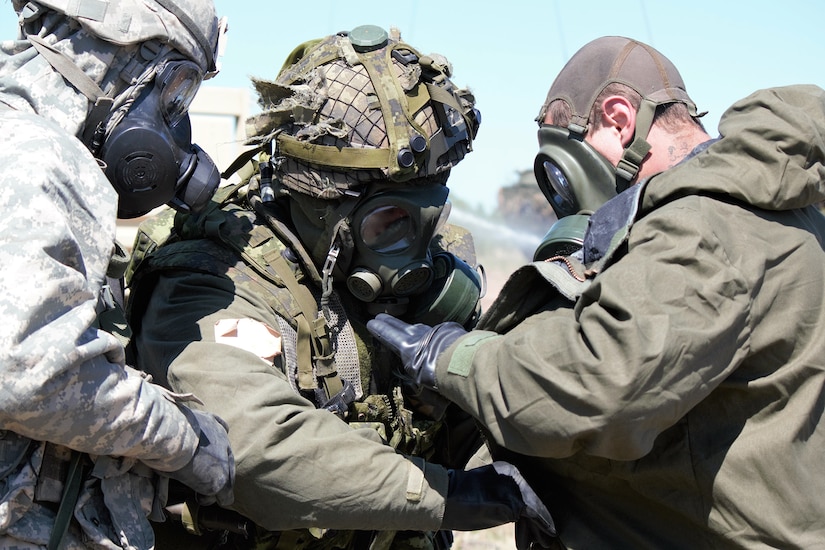By Joshua Ford, U.S. Army North
WAINWRIGHT, Canada -- More than 3,500 Canadian, U.S.,
British, Australian and French forces participated in this year's Exercise
Maple Resolve, providing an opportunity to enhance multinational
interoperability in a brigade-level field training exercise.
U.S. Army North and the Canadian armed forces plan
year-round for the Canadian army's Exercise Maple Resolve, the largest allied
exercise conducted in North America.
More than 1,300 soldiers from the U.S. Army's active,
Reserve and National Guard components participated in the exercise, which was held
here May 13-24.
"If we're going to prepare brigade combat teams to go
to combat, we want them to be able to train with our allies and train as we
fight," said Dave Morrison, Canada branch chief, theater security
cooperation division, U.S. Army North. "So if we're going to deploy with
our partners, we want to train with them."
U.S. Army North coordinates theater security cooperation
activities between the militaries of Canada and the United States to help
maintain interoperability and improve both nations' ability to work together
during global coalition operations.
‘We Know We Need to be Interoperable’
"There are certain areas where we know we need to be
interoperable," said Canadian Lt. Col. Joseph Pospolita, deputy commander,
Canadian Manoeuvre Training Centre. "We know communications is something
we need interoperability with because that effects how we call in requests for
fire and how you coordinate air assets."
Communication isn't the only focus area during the exercise.
Other capabilities practiced included command and control of allied forces,
logistics operations and personnel processing.
This year was the first time the U.S. Army sent an entire
maneuver battalion to the exercise. Other American military assets included
military intelligence, aviation, medical, chemical and logistics units.
The 650th Regional Support Group provided command and
control of all U.S. forces during the exercise.
"It's good for us to get involved in exercises like
Maple Resolve because it's real world versus simulation. We're actually working
off demand to provide logistics, the fuel, the ammunition and the food to all
forces in the field," said Army Col. Rodney J. Fischer, 650th Regional
Support Group commander.
"Every year we look across the force to help identify
which units would benefit most in participating in these exercises. We build
the requirements at [U.S. Army North], including those from other services like
the Marine Corps," Morrison said. "And then we work out how to get
them there and what capabilities we need to support them while they're
there."
Since the exercise is held in Canada, deploying units there
is less resource intensive than sending them overseas to train with allies, but
it still provides the experience of deploying to another nation.
Expeditionary Army
"Traveling to another nation for these exercises is
good, because the Army is looking to
become more expeditionary, so we have to be able to deploy
and project power," Fischer said.
The ultimate goal for the exercise is to certify Canada's
high readiness brigade.
After the exercise, 5th Canadian Mechanized Brigade Group
will be on standby to answer the call if Canada is put in a situation where it
needs to deploy units overseas or within its borders for natural or man-made
disasters.
"The High Readiness Brigade is prepped for any
operation, whether it be domestic or international," Pospolita said.
"If we get a mission overseas and we need a task force or battlegroup to
respond, the country would look to the high readiness brigade
immediately."
An exercise like Maple Resolve doesn't come without its
challenges. Since each nation operates on different systems, getting those
technologies to communicate can prove to be difficult.
"The perfect incident would be you could have multiple
multination battlegroups or brigades operating where they are, each with
different gear, and they seamlessly meld in with our systems," Pospolita
said. "Plug and play is exactly where we're going for here."
Old Allies
U.S. and Canadian forces have been working closely together
from World War II to Operations Enduring and Iraqi Freedom.
"When it comes to straight operability soldier to
soldier, we know how to operate together," Pospolita said. "That's
the easy part. Our soldiers know what they have to do in order to accomplish
the mission."
"It's important for us to operate at the multinational
level because the United States will most likely never go to war alone,"
Fischer said. "We rely on our coalition partners and working out any
issues now makes us that more formidable in the future."
He added, "If we show that capability and our
adversaries know that if they do something wrong then the United States and
Canadians will be there to protect good.”
Maple Resolve continues to grow each year, bringing together
troops from different allied nations and partners.
"It just keeps getting bigger and bigger,"
Morrison said.

No comments:
Post a Comment